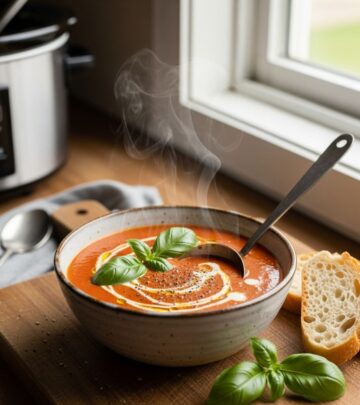A Comprehensive Guide to Hot Borscht: The Iconic Beet and Meat Soup
Explore the history, variations, and mastery of hot borscht—Eastern Europe's most beloved beet and meat soup.

Hot Borscht: The Iconic Beet and Meat Soup
Hot borscht stands as one of the most celebrated dishes in Eastern European cuisine, captivating food lovers with its striking color, earthy flavor, and nourishing heartiness. This vibrant beet-based soup bridges tradition, family customs, and modern kitchens. In this comprehensive guide, you’ll master everything from borscht’s storied history and key ingredients to expert preparation techniques and serving suggestions for this beloved classic.
What Is Borscht?
Borscht is a deeply colored beet soup, often enriched with meat and vegetables, and is especially prominent in Russia, Ukraine, and Poland. While cold borscht variants exist, the hot version is the most iconic, revered for its complex layers of sweet, sour, earthy, and savory flavors. Meat—most often beef or pork—creates a rich broth, while a medley of vegetables and beets gives borscht its signature color and taste.
History and Cultural Significance
Borscht’s roots trace back centuries, making appearances in Slavic folklore, family gatherings, and as a symbol of hospitality. Ukraine is widely considered the birthplace of borscht, but Russia, Poland, Lithuania, and Moldova all have their own variations. Over generations, borscht became synonymous with comfort food—a dish as suitable for festive occasions as for everyday sustenance.
Key Characteristics of Hot Borscht
- Vivid Red or Magenta Color: Driven by beets, which are either grated, chopped, or julienned.
- Sweet and Sour Balance: A defining trait, achieved by pairing beet sweetness with vinegar, lemon juice, or fermented kvass.
- Hearty Texture: Meat and a cornucopia of root vegetables create a thick, satisfying soup.
- Herbal Freshness: Dill, parsley, and sometimes chives provide brightness to every spoonful.
- Tangy Garnishes: Sour cream and horseradish are classic additions, enhancing flavor and mouthfeel.
Core Ingredients
| Primary Ingredient | Function in Soup |
|---|---|
| Beets | Provide color, natural sweetness, and earthy character |
| Meat/Bones | Add depth to the broth; beef shank, brisket, chuck, or pork ribs are most common |
| Cabbage | Lends crunch and contrasts the earthy beets |
| Potatoes | Contribute to hearty texture |
| Carrots | Add color and sweetness |
| Onions & Garlic | Enhance depth and aroma |
| Tomato Paste or Sauce | Provides acidity and a rounder flavor balance |
| Acidifier (Vinegar, Lemon Juice, Kvass) | Accentuates the sweet and sour profile |
| Dill & Parsley | Adds freshness and color |
Step-By-Step Guide: Making Hot Borscht
1. Preparing the Meat Stock
The secret to an unforgettable borscht begins with the broth. Traditional recipes favor beef on the bone, brisket, or pork ribs for their long-simmering flavors. Here’s how to build a flavorful stock:
- Use about 1 to 1.5 pounds (450-700g) of beef shank or pork ribs, with bone for extra richness.
- Place meat in a large pot, cover with about 3 quarts of cold water.
- Add one onion (halved), one carrot (chunked), two celery stalks or a piece of celeriac if available, 2 bay leaves, a teaspoon of salt, and 5-6 peppercorns.
- Bring to a gentle boil, skimming off foam. Reduce to simmer for 1.5 to 2 hours until the meat is fork-tender and the stock is aromatic.
- Remove the meat and vegetables; reserve the meat and strain the broth for clarity.
2. Preparing the Borscht Vegetables
- Beets: Peel and coarsely grate 2-3 medium beets. Some cooks sauté beets for extra flavor, but adding them raw preserves their earthy essence.
- Carrots: Grate 2 medium carrots. Adds a subtle sweetness to the soup.
- Onions and Garlic: Chop 1 onion and 2 cloves garlic. Sauté in sunflower or vegetable oil until golden. This is the zazharka or aromatic base in Slavic cooking.
- Cabbage: Slice half a medium white cabbage into thin shreds. Add toward the end to keep it crisp.
- Potatoes: Cube 2-3 peeled potatoes, about 1-inch pieces.
3. Layering Flavors
Add the prepared beets, carrots, and potatoes to the stock. Simmer for 10–12 minutes. Then add the sautéed onions and garlic, followed by the sliced cabbage. Simmer gently until the vegetables are tender but not mushy (about 10–15 minutes).
4. Building the Sweet-Sour Balance
- Tomato Paste: Stir in about 2-3 tablespoons for a subtle acidity and body.
- Vinegar or Lemon Juice: Add 1 tablespoon of white vinegar or fresh lemon juice to taste. Some traditionalists use beet kvass for an even more complex tang.
- Sugar: Add 1-2 teaspoons, if desired, to round out the tartness and echo the beets’ sweetness.
- Taste and adjust seasonings—a great borscht balances sweet, sour, salty, and earthy notes.
5. Final Touches & Resting
- Return the reserved meat to the pot, sliced or shredded, just before serving. Alternately, place a piece of meat in each bowl for rustic presentation.
- Fresh dill and parsley are stirred in at the last moment for a vibrant, aromatic finish.
- Let the borscht rest for at least 20–30 minutes before serving. Like many stews and soups, its flavors deepen with time. Many even argue that refrigerating overnight yields the best results.
Common Variations
- Vegetarian/Vegan Borscht: Omit the meat and use vegetable or mushroom stock. Add extra beans or mushrooms for a hearty alternative.
- Polish Borscht (Barszcz): Often served clearer, strained, and sometimes with uszka dumplings.
- Lithuanian Borscht: Known for adding kefir or yogurt, especially in cold versions.
- Sour Borscht: Relying heavily on fermentation, with beet or rye kvass replacing all or some of the vinegar.
Serving and Garnishing
Borscht is as much about presentation and accompaniments as the soup itself. The following tips elevate the eating experience:
- Sour Cream: A generous dollop stirred in at the table is traditional and luscious.
- Fresh Dill and Parsley: Sprinkle liberally over each bowl for color and flavor.
- Horseradish Cream: For extra piquancy, combine sour cream or crème fraîche with grated horseradish and a touch of lemon juice and sugar.
- Dark Rye Bread: Thick, crusty slices are the classic accompaniment, perfect for absorbing every drop.
Expert Tips for Perfect Borscht
- Cook vegetables in order: Add sturdier vegetables earlier and delicate ones, like cabbage or fresh herbs, later to avoid overcooking.
- Balance flavors before serving: Taste and tweak the sweet-sour balance last.
- Plan ahead: Borscht tastes better the next day. Make it in advance and reheat gently.
- Don’t over-puree: The best borscht highlights a tapestry of textures, not smooth uniformity.
Nutritional Value
Borscht is not only comforting but also nutritious. Beets are high in fiber, folate, potassium, and antioxidants. The soup is low in fat (unless using fatty cuts or lots of sour cream), and it can be made even leaner in vegetarian versions. Adding beans, as seen in some regional takes, increases its protein and fiber content.
Storage and Make-Ahead Tips
- Refrigeration: Cool to room temperature, then store in an airtight container for up to 4 days. Flavors continue to marry and improve.
- Freezing: Borscht freezes well for up to 2 months. Avoid adding sour cream or fresh herbs before freezing for optimal texture.
- Reheating: Warm gently on the stovetop, not at a rolling boil, to preserve flavors and textures.
Frequently Asked Questions (FAQs)
Q: Can I make borscht vegetarian or vegan?
A: Absolutely. Simply omit the meat and use a strongly flavored vegetable or mushroom broth. Add beans or mushrooms for extra body and protein.
Q: Is it necessary to peel beets before using them?
A: Yes, peeling removes bitterness and gritty texture. Scrub and peel beets before grating or chopping for the soup.
Q: Why is my borscht not red?
A: The iconic red comes from beets. Overcooking, using old beets, or adding alkaline ingredients may dull the color. Add a splash of acid—vinegar or lemon juice—at the end to preserve hue.
Q: Can I use canned or pre-cooked beets?
A: For best flavor and texture, use raw beets. Canned or cooked beets are a time-saver but may offer less vibrant taste and color.
Q: How can I store leftovers?
A: Store in the refrigerator for up to 4 days or freeze for up to 2 months. Borscht often tastes richer after a day’s rest.
Conclusion
Preparing borscht is an act of culinary heritage, one where humble ingredients become a dish steeped in tradition, taste, and color. Whether you prefer it with hearty chunks of beef, made vegan, or adorned with only the sweetest beets and sharpest sour cream, hot borscht is a meal that brings warmth and vibrancy to any table. Enjoy discovering your own perfect version of this classic soup.
Read full bio of medha deb












